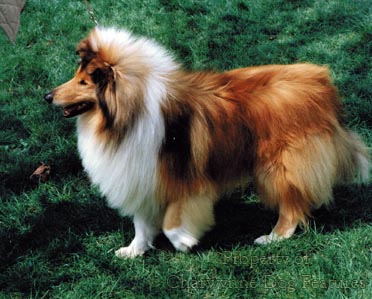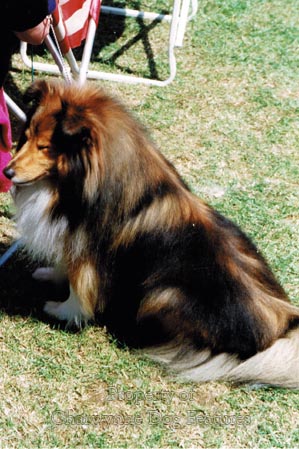605 Destruction of Type
DESTROYING BREED TYPE
by David Hancock
 I am a Bull Terrier fan but I have no wish to own a dog with a ruggerball for a head. How can such a feature be justified? It is not historically correct. I meet would-be Bull Terrier ownwers quite regularly who will not proceed with a purchase whilst this strange head is a breed feature. There were over three thousand Bull Terrier registrations in 2007 but over 12,000 of the unaltered Staffordshire BT. Twenty years ago when I wrote of my concern over the loss of true type in the head of the Bull Terrier, the wealthy owner of a large kennel wrote a patronising response, not answering the points being made but defending his personal whim. That perhaps illustrates very aptly the point that breeders and breed clubs can at times lose their way and firm guardianship at Kennel Club level is vital in perpetuating true type in our precious breeds.
I am a Bull Terrier fan but I have no wish to own a dog with a ruggerball for a head. How can such a feature be justified? It is not historically correct. I meet would-be Bull Terrier ownwers quite regularly who will not proceed with a purchase whilst this strange head is a breed feature. There were over three thousand Bull Terrier registrations in 2007 but over 12,000 of the unaltered Staffordshire BT. Twenty years ago when I wrote of my concern over the loss of true type in the head of the Bull Terrier, the wealthy owner of a large kennel wrote a patronising response, not answering the points being made but defending his personal whim. That perhaps illustrates very aptly the point that breeders and breed clubs can at times lose their way and firm guardianship at Kennel Club level is vital in perpetuating true type in our precious breeds.
Of course, a number of old breeds have been improved without any discernible loss of type. The founding dogs in a number of breeds were physically quite dreadful and skilful breeders have improved quality discernibly since those early days. But type can be lost in any breed at any time if breed clubs are not collectively vigilant. It is never a case of type perpetuating itself; it has to be consciously sought. Genetic tendencies have to be countered if they lead breeds away from the essence of the breed. The short face for example is dominant and in breeds like the Bullmastiff, breeders have to be watchful that muzzles don't become untypically short and giant fawn or brindle bulldogs result.
Basset hounds and Cocker Spaniels now have ears which are untypically too long. Rough Collies and Shetland Sheepdogs now have coats which are untypically too heavy. Dachshunds' legs are now untypical because they are too short. Stockard concluded many years ago that short legs were dominant. At what stage do we acknowledge that they have become too short in a breed, too short that is for the good of the dog rather than the pocket of the breeder? We are steadily losing the true Labrador head. Our Airedales sadly seem to get more soppy each year -- how I miss the gameness and spirit once such an attractive feature of this excellent breed.
But if you raise these points, as matters of sincere interest and genuine concern with breeders at shows or seminars you get a very disappointing reaction. This can vary from "we like what we've got, so what's the problem?" to downright resentment. To me such reactions indicate a lack of any real affection for a breed. It is foolish to regard any dog registered with the KC as a purebred product as having true type just because it is a registered pedigree dog. Type in any breed of dog is far more subtle and a lot more elusive than that. For me dogs with the genuine look of their breed are always to be preferred to untypical specimens with "papers". 
Is a German Shepherd Dog with a roach back, hyper-angulation in its hindquarters and a lack of substance, with two showring wins and KC registration to be preferred to an upstanding, well-boned and symmetrically built dog with a level topline but no papers? Contemporary GSD breeders seem to have lost their way and it's going to take decades to restore true type to this quite outstanding breed. I wholeheartedly agree with Lady Malpas, who wrote a few years ago to one of the dog papers: "There can be no justification for any attempt, accidental or intentional, to produce different types of German shepherd." I also support the view of a GSD breed correspondent who wrote: "What has happened to this noble breed? I was brought up in the school that had as a pattern dogs like Ch. Fenton of Kentwood, Ch. Sergeant of Rozavel and other famous dogs of similar type. My mentors told me that a good Alsatian could carry a glass of water on its back without spilling when moving..."
The service to man of the German Shepherd Dog is difficult for any other breed to match. I have seen them at work and witnessed their versatility in nearly twenty different countries. I had always considered their breed type to be fixed. Unlike manufactured breeds like the Dobermann and the Bullmastiff, there is no risk of a strong prototypal ancestor-breed like the Greyhound or the Bulldog manifesting itself. Any breeder who tampers with a breed type long established, long accepted and long proven able to produce an intelligent, healthy, biddable dog is a dangerous, misguided maverick who should be halted in his tracks.
In any breed of pedigree dog it only takes one determined breeder with more money than sense to promote his concept or a dominant clique to gain ascendancy for true type to be threatened. Breeds don't just lose type; breeders lose their way. But who lets them? Two hundred years ago, Edmund Burke was writing: "An event has happened, upon which it is difficult to speak, and impossible to be silent." Those who love dogs for what they are, as opposed to what they're worth, must always find it impossible to be silent. In this way gratitude is shown to those who handed our precious breeds of dog down to us. It demonstrates too an awareness of our duty to those who come after us. If you care -- speak up!